If you find that your little one has not been able to crawl, even though he is already 9 months old, try not to worry too much. Every baby has a different rate of growth and development, so it is possible that he can only crawl after he is over 9 months old.
Before being able to stand and walk, it is important for babies to learn to crawl first. By getting used to crawling, the baby's muscles will become stronger to support his body when standing and walking later.

Babies generally learn to crawl by balancing their bodies in a position supported on hands and knees first. After that, he will find a way to move back and forth from this position by pushing his knees.
You may be wondering, at what age should babies start crawling? Check out the following explanation.
Know When Baby Has Started Crawling
Most babies have started learning to crawl around the end of 6 months or around 7-10 months. However, if your little one has not been able to crawl even though he has reached 9 months, it does not mean that his development is disrupted. Babies with normal and healthy growth and development are also late crawling.
Your little one's risk for crawling late will be higher if he is born before 37 weeks of gestation or is born prematurely. However, over time, your little one will crawl if his body is ready. While waiting for his body to be ready, you can start guiding your baby to learn to crawl.
Come on, Train Your Little One to Crawl
To help your little one learn to crawl, you can take the following steps:
1. Invite your little one to play while in a prone position
Lay your little one on his stomach and play with him for a few minutes. The prone position can train your little one to be stronger to support his head and strengthen his back. This can help strengthen the body muscles needed to crawl.
In addition to stimulating the little one's desire to crawl, the prone position can also prevent the baby's head from being full from lying on his back too much.
2. Reduce usage baby walker or swing
Swing or walker (baby walker) maybe you need your little one to be safe and not fussy when you do other activities. However, these two objects limit your little one's movement, so he can take longer to strengthen the body muscles needed to crawl.
3. Lure the Little One to move
The best way to encourage your little one to crawl is to get him moving. Try laying your little one on his stomach, then place the toy a little further in front of him so that he is encouraged to grab it.
Another trick is to put a mirror in front of your little one. Seeing his own reflection in the mirror can motivate him to move gradually to a crawl.
4. Provide a comfortable space for him to explore
Fill one of the areas on the floor of the house with toys and other interesting things so he can move around the room. However, you need to always supervise your little one while playing and make sure the condition of the house is clean and safe to explore.
5. Demonstrate how to crawl
Your little one will probably crawl faster if you give an example of how to crawl. That way, your little one can imitate what you do.
When should you be alert?
Your little one has not been able to crawl when he is 9 months old, does not necessarily indicate that he is experiencing growth and development problems. However, you need to be careful if at that age he can't crawl and shows delays in other aspects of growth and development, such as:
- Your baby is unable to support his or her own head or body weight and appears limp or doesn't have the energy to move.
- Your little one is not able to roll over, crawl, or crawl even though he is 1 year old.
- Little ones tend to only move one side of the body. This condition can be a sign of a dangerous condition or the presence of a neurological disorder, such as cerebral palsy or cerebral palsy cerebral palsy.
- Little ones are less responsive and unenthusiastic when invited to play.
If you feel restless if your little one who is 9 months old has not been able to crawl or if your little one is experiencing some of the above growth and development problems, you can take him to the pediatrician for a growth check-up and proper treatment.









